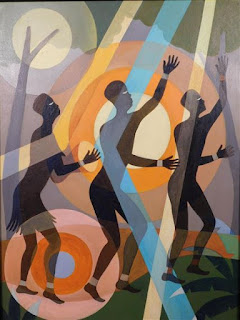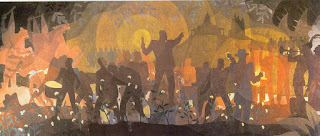Aaron Douglas (born May 26, 1899) was an African-American painter, illustrator and graphic artist who played a leading role in the Harlem Renaissance of the 1920s and 1930s.
Douglas had a unique artistic style that fused his interests in modernism and African art. His best-known paintings are semi-abstract, and feature flat forms, hard edges, and repetitive geometric shapes. Bands of color radiate from the important objects in each painting, and where these bands intersect with other bands or other objects, the color changes. A student of German-born painter Winold Reiss, he incorporated parts of Art Deco along with elements of ancient Egyptian wall paintings in his work. Many of his figures appeared as bold silhouettes.
Douglas contributed illustrations to Opportunity, the National Urban League's magazine, and to The Crisis, put out by the NAACP. These were the two most important magazines associated with the Harlem Renaissance at the time. He created powerful images of African-American life and struggles, and won awards for the work he created for these publications. His designs brought him to the attention of W.E.B. Du Bois and Dr. Alain Locke who were looking for young African American artists to express their African heritage and African American folk culture in their art. He ultimately received a commission to illustrate an anthology of philosopher Locke's work, entitled The New Negro.
By 1939, Douglas started teaching at Fisk University, where he remained for the next 27 years.
Aaron Douglas was considered the "Father of African American arts." That title led him to say," Do not call me the Father of African American Arts, for I am just a son of Africa, and paint for what inspires me."
His striking illustrations, murals, and paintings of the life and history of people of color depict an emerging black American individuality in a powerfully personal way. Douglas linked black Americans with their African past and proudly showed black contributions to society decades before the dawn of the civil rights movement. His work made a lasting impression on future generations of black artists including myself (he is one of my favorites).
David C. Driskell, artist and a leading educator and scholar of African American art said, "At a time when it was unpopular to dignify the black image in white America, Douglas refused to compromise and see blacks as anything less than a proud and majestic people."
Douglas died in February 1979 in Nashville, at the age of 79.



































































No comments:
Post a Comment